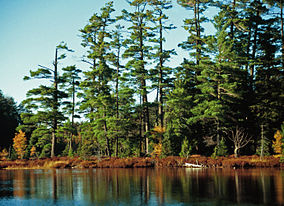Sylvania Wilderness
| Sylvania Wilderness | |
|---|---|
wilderness area) | |
 Katherine Lake | |
| Location | Gogebic County, Michigan, United States |
| Nearest city | Marquette, Michigan |
| Coordinates | 46°12′58″N 89°17′53″W / 46.216°N 89.298°W |
| Area | 18,327 acres (7,417 ha) |
| Established | 1987 |
| Governing body | U.S. Forest Service |
| www | |
Sylvania Wilderness is an 18,327 acres (7,417 ha) protected area located a few miles west of
Within its borders lie 34 lakes set against a backdrop of
History

Little is known of the area prior to the late 1800s, other than the area was frequently used by clans of Ojibwe Native Americans, as evidenced by the few scattered artifacts that have been found there. In 1895, a Wisconsin lumberman by the name of A.D. Johnston purchased 80 acres (32 ha) of land at the south end of Clark Lake with the intent to cut the large pines located there. Upon seeing the land for himself, he was so taken by the rugged beauty of it that he changed his mind and decided to preserve it. He soon invited friends, many of whom were equally impressed and so moved to purchase adjacent lands, and after some time the Sylvania Club was formed, with fishing, hunting, and hiking being the main focus. The owners built lodges and cabins on the larger lakes, and the area became an exclusive resort for a small number of affluent and influential guests. Ownership changed hands over the years, and finally the entire area was purchased by the United States Forest Service in 1967, which promptly removed all buildings and began managing it as a special recreation area. In 1987, it was designated as a federal wilderness when the Michigan Wilderness Act was passed by Congress and signed into law by Ronald Reagan.
Geography
Sylvania straddles the divide between the Lake Superior and the Mississippi River drainage systems, occupying some of the highest ground in the
There are 50 designated campsites in 29 locations throughout the wilderness, each with rudimentary amenities such as outdoor toilets, tent pads, pack racks (for keeping foodstuffs out of reach of wildlife), and fire-grills.
Flora and fauna
The old-growth
Wildlife abounds in the park, with
, and many others.List of major lakes in Sylvania
- Big Bateau Lake
- Clark Lake
- Clear Lake
- Crooked Lake
- Deer Island Lake
- Devils Head Lake
- Dream Lake
- East Bear Lake
- Fisher Lake
- Florence Lake
- Glimmerglass Lake
- Helen Lake
- High Lake
- Indian Lake
- Katherine Lake
- Little Duck Lake
- Long Lake
- Loon Lake
- Marsh Lake
- Moss Lake
- Mountain Lake
- Snap Jack Lake
- West Bear Lake
- Whitefish Lake
References
- ^ Mary Byrd Davis (23 January 2008). "Old Growth in the East: A Survey". Archived from the original on 17 February 2012. Retrieved 27 August 2013.
External links
- Sylvania Wilderness and Recreation Area, Ottawa National Forest U.S. Forest Service
- Map of Sylvania Wilderness, Ottawa National Forest U.S. Forest Service

